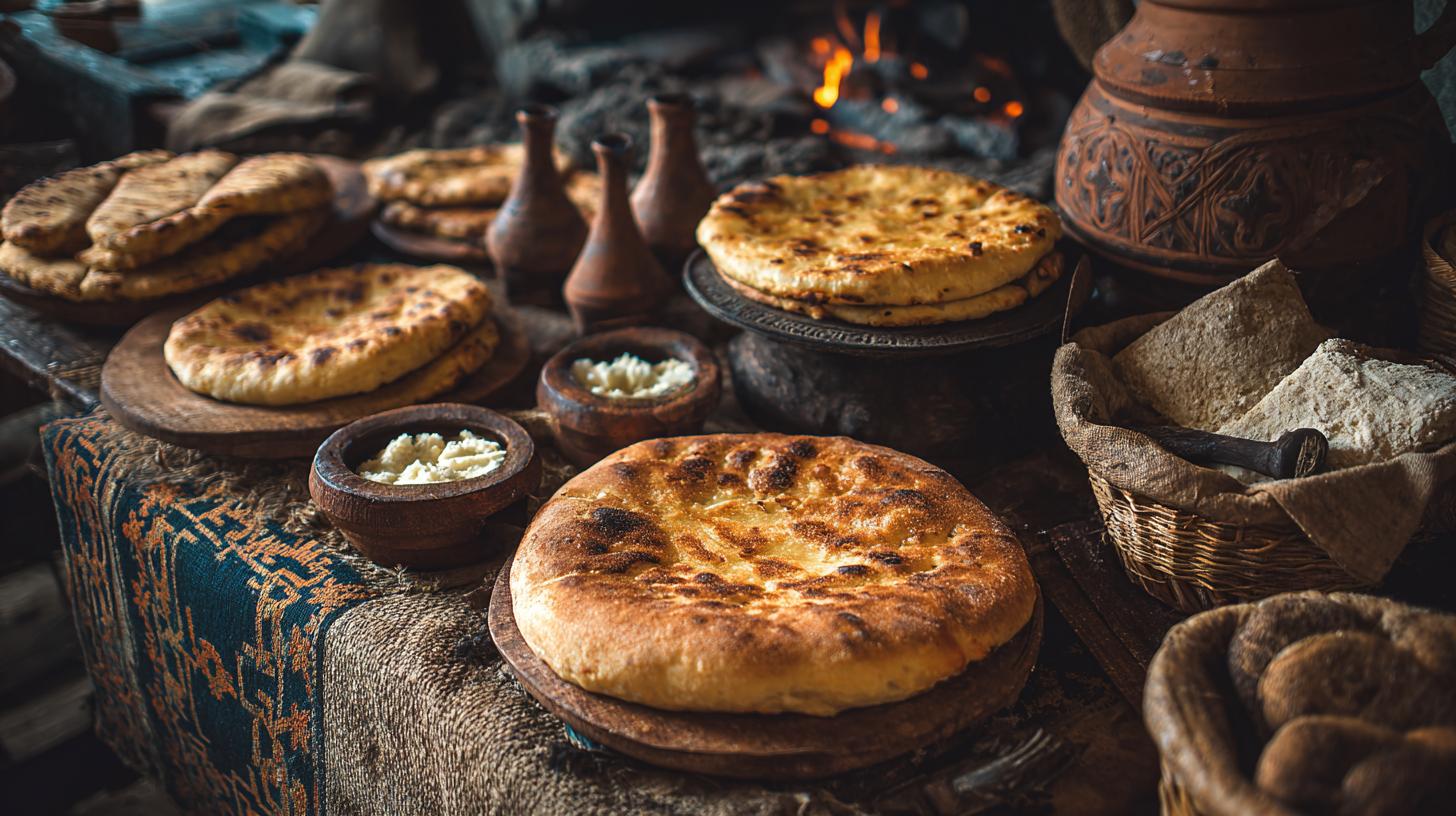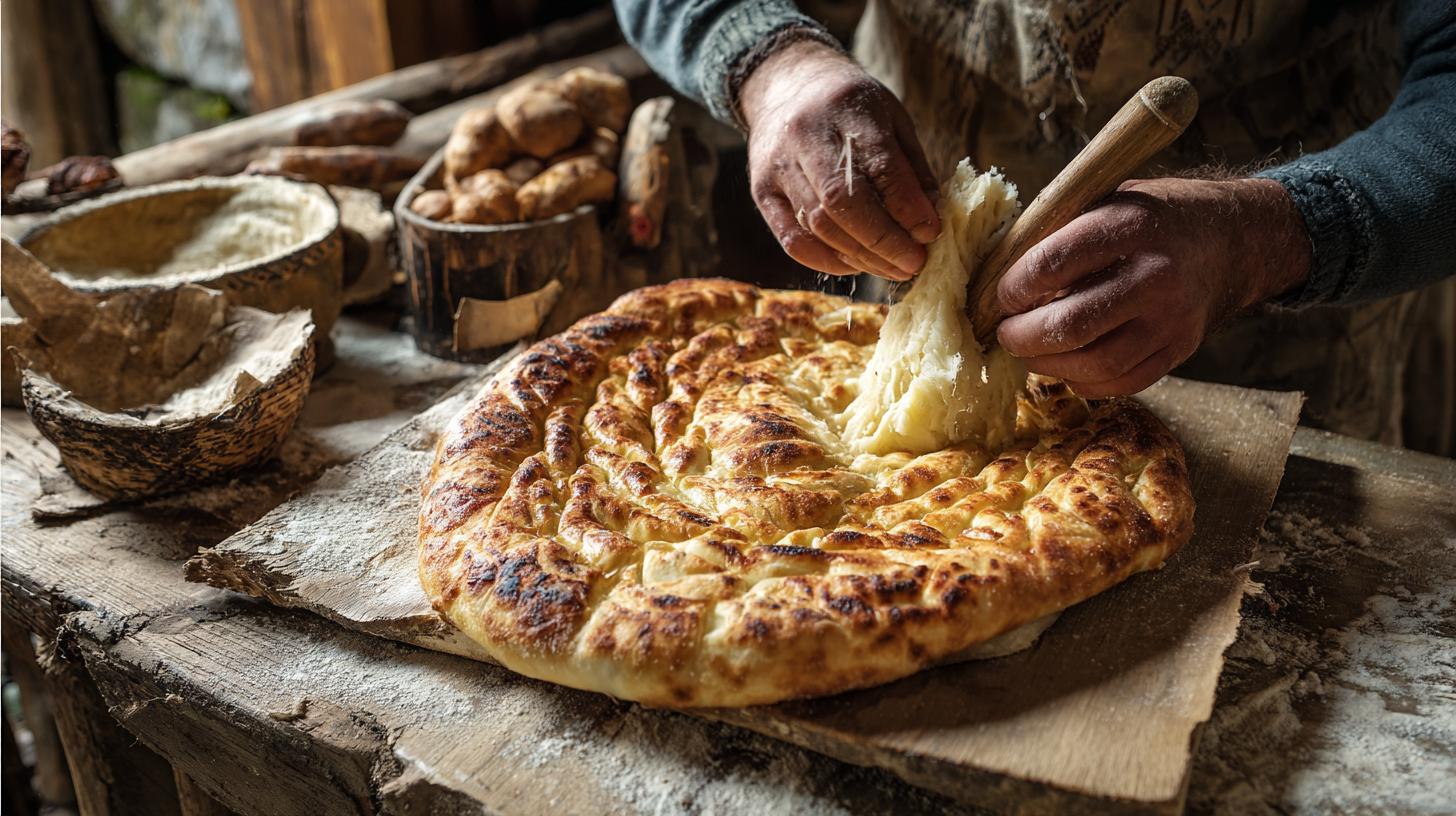Introduction to Khachapuri: More Than Just a Dish

When we think about traditional Georgian cuisine, one iconic dish immediately comes to mind: khachapuri. This cheese-filled bread has become synonymous with the country’s culinary identity. But khachapuri is far more than just a tasty snack or meal; it represents centuries of cultural tradition and history. The history of khachapuri and its UNESCO nomination are deeply intertwined with Georgia’s national pride and the preservation of its culinary heritage. This article will take you through the fascinating journey of khachapuri, exploring its origins, variations, and the significance behind its recent nomination to UNESCO’s Intangible Cultural Heritage list.
The Origins of Khachapuri: Tracing Its Roots Through Time
The history of khachapuri and its origins are as rich and diverse as the country itself. Georgia, situated at the crossroads of Europe and Asia, has been a melting pot of cultures, traditions, and culinary innovations for thousands of years. Khachapuri, in many ways, reflects this unique cultural blend.
The earliest records of bread filled with cheese in Georgian cuisine date back to centuries ago, though exact documentation is scarce due to the oral nature of traditional recipes. Historically, Georgians relied heavily on bread and cheese as staple foods. The idea of combining these two basic ingredients into one dish likely arose out of practicality as well as taste preferences. Imagine the convenience and richness of bread stuffed with soft, melted cheese – it made for a satisfying meal that was easy to prepare and consume, especially for shepherds and travelers.
Ancient Baking Techniques and Ingredients
Traditional Georgian bread-making techniques have passed down through generations, with khachapuri reflecting this continuity. The dough for khachapuri is made from simple ingredients: flour, water, salt, and yeast. The cheese filling typically consists of local varieties such as sulguni and imeruli — semi-soft to soft cheeses that melt beautifully inside the bread. These cheese varieties originated in different regions of Georgia and are fundamental to the dish’s authenticity.
Beyond just bread and cheese, some recipes also include eggs or butter, which enrich the flavor and texture. These additional ingredients complement the basic composition and give rise to the various regional styles of khachapuri found throughout Georgia.
Exploring Regional Variations of Khachapuri
The history of khachapuri and its UNESCO nomination cannot be fully understood without recognizing the diverse regional variations within Georgia. Each region has adapted khachapuri to local tastes, ingredients, and customs, resulting in a rich culinary tapestry.
Adjarian Khachapuri
Perhaps the most internationally recognizable version, Adjarian khachapuri comes from the Adjara region near the Black Sea. This variation resembles a boat-shaped bread filled with cheese, topped with a raw egg yolk and a pat of butter before serving. The presentation is distinctive, as diners mix the molten cheese, egg, and butter together before eating the bread by tearing off pieces to dip into the delicious filling.
Imeretian Khachapuri
In Imereti, a region in western Georgia, khachapuri is circular and stuffed with Imeruli cheese. Compared to the Adjarian version, Imeretian khachapuri has a more uniform, closed appearance like a traditional stuffed bread or pie. It is one of the most common and widely consumed variations and is straightforward but full of flavor.
Mingrelian Khachapuri
From the neighboring region of Mingrelia comes a variation similar to Imeretian khachapuri but with an important twist: the cheese is not only inside the bread but also spread on top. This adds an extra layer of cheesiness and makes the bread visually appealing with a golden, bubbling cheesy crust.
Other Regional Variants
Throughout Georgia, there are additional versions of khachapuri, including:
- Guria Khachapuri: Made with a special mixture of local cheeses.
- Rachuli Khachapuri: Known for adding eggs within the dough.
- Samtskhe-Javakheti Khachapuri: Often made with bryndza cheese and herbs.
These regional versions illustrate how the history of khachapuri and its UNESCO nomination are inseparable from the cultural diversity across Georgian provinces.
Khachapuri’s Place in Georgian Society and Tradition

Khachapuri has never been just food in Georgia— it holds symbolic and social importance. It is often served at celebrations, holidays, family gatherings, and even as an everyday staple. Its preparation and consumption bring people together, serving as an expression of hospitality and communal bonds.
In traditional Georgian supra (feast) culture, khachapuri is indispensable. It is served alongside other national dishes and is central to the ritual of sharing food. The bread-cheese combination reflects the land’s abundance and the skill of Georgian bakers and cheesemakers. In many households, khachapuri is considered a comfort food, evoking memories of home and family.
Gender and Generational Roles in Khachapuri Preparation
The preparation of khachapuri traditionally falls within domestic roles, often handed down from mother to daughter. This passing down of recipes and techniques is a cultural transmission method that enriches the history of khachapuri and supports the dish’s continued relevance.
Cheesemaking and bread-baking themselves are crafts requiring considerable skill and knowledge about local ingredients and timing. Hence, khachapuri represents not just the food itself but a heritage of culinary expertise.
The Process Behind Khachapuri’s UNESCO Nomination

In recent years, the history of khachapuri and its UNESCO nomination have become subjects of national interest and pride. The drive to nominate khachapuri for recognition by UNESCO recognizes more than culinary excellence; it acknowledges the cultural, social, and historical significance of this dish.
What Does UNESCO Intangible Cultural Heritage Status Mean?
UNESCO’s Intangible Cultural Heritage list protects traditions, knowledge, and skills passed through generations that define cultural identities. Unlike World Heritage Sites, which are physical places, intangible heritage includes practices such as storytelling, rituals, performing arts, and — importantly — culinary traditions.
By nominating khachapuri, Georgia aims to highlight the role of traditional foodways in maintaining cultural identity, community cohesion, and sustainable practices in food production and preparation.
Key Steps in the Nomination Process
The nomination of khachapuri involved comprehensive documentation demonstrating its cultural importance, history, and living traditions:
| Step | Description |
|---|---|
| Research and Documentation | Anthropologists, chefs, and cultural experts collected data on khachapuri’s history, recipes, and sociocultural context. |
| Community Involvement | Local communities and bakers were engaged to validate the shared cultural heritage and current practices. |
| Drafting the Nomination File | Information was compiled per UNESCO requirements detailing the intangible cultural heritage worth preserving. |
| Submission and Review | The nomination file was submitted to UNESCO and reviewed by expert committees. |
| Awareness Campaigns | Public campaigns raised awareness within Georgia and internationally about khachapuri’s significance. |
These steps show how seriously Georgia treats the history of khachapuri and its quest for formal global recognition.
Challenges and Considerations in Khachapuri’s UNESCO Nomination
While the nomination process highlights khachapuri’s cultural importance, it also presents some challenges and deeper questions about culinary heritage and globalization.
Standardization vs. Diversity
One issue with any UNESCO nomination of a food tradition is conforming to a “standard” way of making it. Khachapuri’s many regional forms raise questions about which recipe or style best represents the heritage. The nomination process must balance celebrating diversity while maintaining a unified heritage identity.
Impact of Modernization and Tourism
With growing popularity abroad, khachapuri has expanded into fast-food franchises and adapted versions to cater globally. While this proliferation spreads awareness of Georgian cuisine, it risks diluting traditional methods and cultural meanings.
The nomination promotes safeguarding authentic practices, encouraging the use of local ingredients and traditional techniques even as khachapuri evolves.
Preservation of Artisan Skills
UNESCO recognition helps emphasize the importance of preserving artisanal baking and cheesemaking within Georgia. Supporting small-scale farmers, bakers, and cheesemakers is essential for maintaining the authenticity behind the history of khachapuri and its cultural value.
Khachapuri in Contemporary Georgian Life
Today, khachapuri continues to thrive both in Georgia and among diasporas worldwide. Georgian bakers proudly innovate while honoring traditional methods. Local festivals celebrate khachapuri, attracting visitors keen to experience authentic Georgian cuisine.
In Tbilisi and other major cities, khachapuri is readily available, ranging from humble homemade versions to gourmet café interpretations. It remains a vital symbol of Georgian identity, comfort, and community.
Popular Khachapuri Festivals and Events
Several events highlight khachapuri’s cultural role, including:
- Khachapuri Festival of Batumi: Showcases Adjarian khachapuri, with baking competitions and workshops.
- Tbilisi Food Festival: Features a wide array of Georgian dishes, including multiple khachapuri styles.
- International Gastronomy Exhibitions: Promote Georgian food culture and khachapuri worldwide.
These gatherings not only celebrate the dish but also help educate new generations about the dish’s origins and importance.
Global Influence and Reception of Khachapuri
The history of khachapuri and its UNESCO nomination has brought fresh international attention to the dish. Food enthusiasts and cultural scholars alike recognize khachapuri as an example of how food practices express national identity and reflect centuries of history.
Internationally, Georgian restaurants proudly feature khachapuri as a representative dish. Culinary tourism to Georgia often includes khachapuri tasting as a highlight. The dish’s appeal lies in its simplicity combined with rich flavor and cultural narrative.
Comparison with Other World Cheese Breads
Khachapuri joins a global family of cheese-filled breads, but its unique character stands out due to:
| Cheese Bread | Region | Distinctive Feature |
|---|---|---|
| Khachapuri | Georgia | Combination of regional cheeses, diverse shapes, integration of egg and butter, rich cultural symbolism |
| Cheese Naan | India | Flatbread with cheese stuffing, generally spiced |
| Cheese Börek | Turkey and Balkans | Phyllo dough layered with cheese filling |
| Quesadilla | Mexico | Griddled tortillas with melted cheese inside |
The khachapuri stands apart through its association with Georgian tradition and its format as a baked bread that varies significantly by region.
Looking Forward: The Future of Khachapuri’s Cultural Heritage
The journey of the history of khachapuri and its UNESCO nomination is a living story. It teaches us about the importance of food in cultural identity and the need to preserve culinary traditions amid globalization and modernization.
Georgia’s commitment to safeguarding khachapuri ensures that future generations will appreciate its meanings beyond flavor: as a vessel of tradition, community, and history. The recognition by UNESCO would provide added protection, global visibility, and respect to this culinary heritage, encouraging sustainable and authentic practices.
Educational programs, artisanal workshops, and festivals play key roles in passing the knowledge forward, ensuring that khachapuri remains a symbol of Georgian culture embedded in everyday life and special occasions alike.
In everyday kitchens and grand supra tables, khachapuri continues to tell the story of the Georgian people—a story of resilience, creativity, and shared joy. Its history is not frozen in time but evolves with each generation, carrying old traditions into the future, piece by piece, bite by bite.